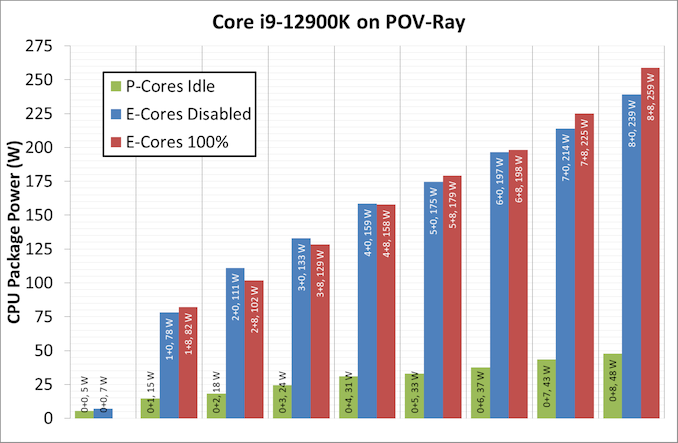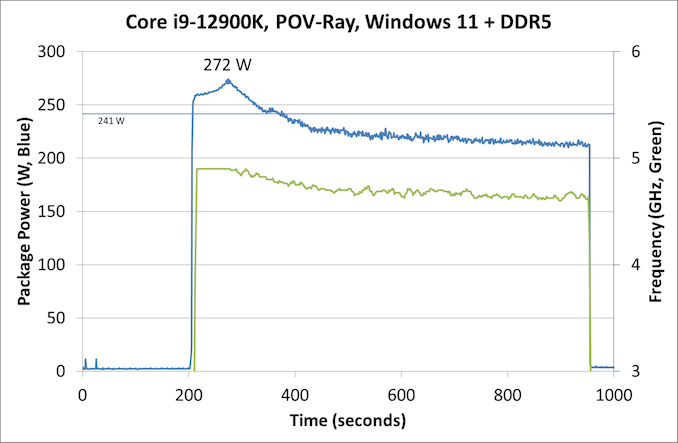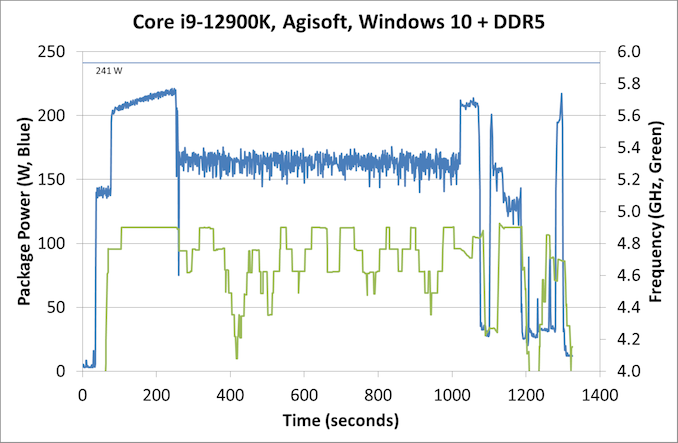The Intel 12th Gen Core i9-12900K Review: Hybrid Performance Brings Hybrid Complexity
by Dr. Ian Cutress & Andrei Frumusanu on November 4, 2021 9:00 AM ESTPower: P-Core vs E-Core, Win10 vs Win11
For Alder Lake, Intel brings two new things into the mix when we start talking about power.
First is what we’ve already talked about, the new P-core and E-core, each with different levels of performance per watt and targeted at different sorts of workloads. While the P-cores are expected to mimic previous generations of Intel processors, the E-cores should offer an interesting look into how low power operation might work on these systems and in future mobile systems.
The second element is how Intel is describing power. Rather than simply quote a ‘TDP’, or Thermal Design Power, Intel has decided (with much rejoicing) to start putting two numbers next to each processor, one for the base processor power and one for maximum turbo processor power, which we’ll call Base and Turbo. The idea is that the Base power mimics the TDP value we had before – it’s the power at which the all-core base frequency is guaranteed to. The Turbo power indicates the highest power level that should be observed in normal power virus (usually defined as something causing 90-95% of the CPU to continually switch) situation. There is usually a weighted time factor that limits how long a processor can remain in its Turbo state for slowly reeling back, but for the K processors Intel has made that time factor effectively infinite – with the right cooling, these processors should be able to use their Turbo power all day, all week, and all year.
So with that in mind, let’s start simply looking at the individual P-cores and E-cores.
Listed in red, in this test, all 8P+8E cores fully loaded (on DDR5), we get a CPU package power of 259 W. The progression from idle to load is steady, although there is a big jump from idle to single core. When one core is loaded, we go from 7 W to 78 W, which is a big 71 W jump. Because this is package power (the output for core power had some issues), this does include firing up the ring, the L3 cache, and the DRAM controller, but even if that makes 20% of the difference, we’re still looking at ~55-60 W enabled for a single core. By comparison, for our single thread SPEC power testing on Linux, we see a more modest 25-30W per core, which we put down to POV-Ray’s instruction density.
By contrast, in green, the E-cores only jump from 5 W to 15 W when a single core is active, and that is the same number as we see on SPEC power testing. Using all the E-cores, at 3.9 GHz, brings the package power up to 48 W total.
It is worth noting that there are differences between the blue bars (P-cores only) and the red bars (all cores, with E-cores loaded all the time), and that sometimes the blue bar consumes more power than the red bar. Our blue bar tests were done with E-cores disabled in the BIOS, which means that there might be more leeway in balancing a workload across a smaller number of cores, allowing for higher power. However as everything ramps up, the advantage swings the other way it seems. It’s a bit odd to see this behavior.
Moving on to individual testing, and here’s a look at a power trace of POV-Ray in Windows 11:
Here we’re seeing a higher spike in power, up to 272 W now, with the system at 4.9 GHz all-core. Interestingly enough, we see a decrease of power through the 241 W Turbo Power limit, and it settles around 225 W, with the reported frequency actually dropping to between 4.7-4.8 GHz instead. Technically this all-core is meant to take into account some of the E-cores, so this might be a case of the workload distributing itself and finding the best performance/power point when it comes to instruction mix, cache mix, and IO requirements. However, it takes a good 3-5 minutes to get there, if that’s the case.
Intrigued by this, I looked at how some of our other tests did between different operating systems. Enter Agisoft:
Between Windows 10 and Windows 11, the traces look near identical. The actual run time was 5 seconds faster on Windows 11 out of 20 minutes, so 0.4% faster, which we would consider run-to-run variation. The peaks and spikes look barely higher in Windows 11, and the frequency trace in Windows 11 looks a little more consistent, but overall they’re practically the same.
For our usual power graphs, we get something like this, and we’ll also add in the AVX-512 numbers from that page:

Compared to Intel’s previous 11th Generation Processor, the Alder Lake Core i9 uses more power during AVX2, but is actually lower in AVX-512. The difficulty of presenting this graph in the future is based on those E-cores; they're more efficient, and as you’ll see in the results later. Even on AVX-512, Alder Lake pulls out a performance lead using 50 W fewer than 11th Gen.
When we compare it to AMD however, with that 142 W PPT limit that AMD has, Intel is often trailing at a 20-70 W deficit when we’re looking at full load efficiency. That being said, Intel is likely going to argue that in mixed workloads, such as two software programs running where something is on the E-cores, it wants to be the more efficient design.














474 Comments
View All Comments
Spunjji - Friday, November 5, 2021 - link
This. People often get halfway through the analogy and then give up when they think it's made their argument for them.Dribble - Sunday, November 7, 2021 - link
The having lots of potential power and high power consuption is exactly what mobile phones and laptop cpu's do. That Intel do that in desktops too is not surprising.Spunjji - Friday, November 5, 2021 - link
99% of users don't need a 12900K. Presumably the people who do are likely to use it for these tasks where it will actually show a performance improvement over a cheaper CPU (accepting that some people overspend for e-peen reasons and will buy one for gaming where a 12600K would do just as well).lmcd - Friday, November 5, 2021 - link
99.9999999999% of users don't need a 12900K peak performance constantly, even if they will use the peak performance sometimes, including times when it definitely counts.I won't lie and say I have the best of the best, but Zen 2 vs Zen 1 cut down my build times noticeably. That helps keep me in flow, even if it's only saving me a few minutes per day. For people like me with ADHD or other attention-related issues, this can be a massive boon.
brucethemoose - Thursday, November 4, 2021 - link
Does efficiency really matter for top end desktop SKUs? Intel/AMD tend to clock these near their voltage walls, WAY outside the "sweet spot" of a given architecture, and you can get a boatload of efficiency back just dropping boost clocks by 10% yourself.Now, if the laptop SKUs end up being power hungry, thats a different story.
Blastdoor - Thursday, November 4, 2021 - link
Same core design, same process. So.... I'm sure Intel will lower clocks for mobile and servers to get power usage down, but once they lower the clocks, how will the performance compare?meacupla - Thursday, November 4, 2021 - link
For now, efficiency doesn't matter for desktops, but in a few years time, we are very likely to see laws passed that will mandate high efficiency in high end desktops.There are already some legislation in the works that calls for exactly this, but have not been passed yet.
TheinsanegamerN - Thursday, November 4, 2021 - link
And how, pray tell, are they going to legislate that? Max power usage for a CPU? We've already seen how california tried it, and predictably they made a mess of it.INB4 intel just refuses to sell anything but a celeront o californians and mysteriously tech resellers in arizona get a bunch of cali orders. Hmmmm.....
meacupla - Thursday, November 4, 2021 - link
don't ask me, IDK how law makers will do it. Just be aware that there are some really dumb laws that are already in existence, and the world is going to be entering an age of power shortages, along with carbon neutral incentives.Considering how things are going currently, I think it'll just be a 100% tax on desktop CPUs that can't hit some efficiency metric that Apple has designed.
Wrs - Thursday, November 4, 2021 - link
Doubtful given how poorly the existing law works. All they do is measure computer idle wattage. The lawmakers aren't techies. And they're busy handling the blowback from carbon neutrality bills that the pubic believes are related to power shortages and cost spikes.